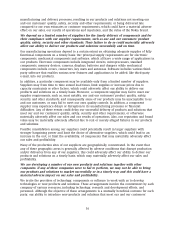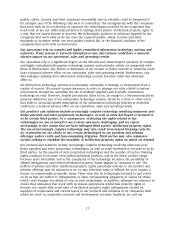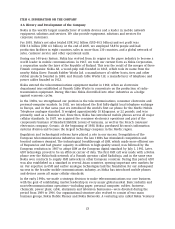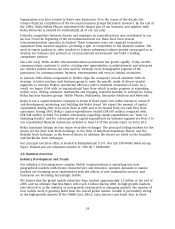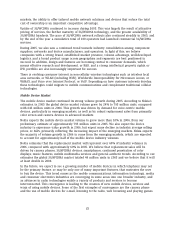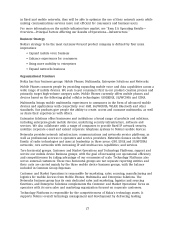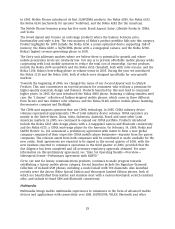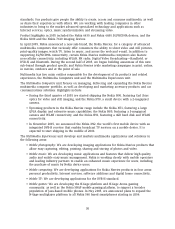Nokia 2005 Annual Report Download - page 22
Download and view the complete annual report
Please find page 22 of the 2005 Nokia annual report below. You can navigate through the pages in the report by either clicking on the pages listed below, or by using the keyword search tool below to find specific information within the annual report.Customer financing to network operators can be a competitive requirement and could
adversely and materially affect our sales, results of operations, balance sheet and cash flow.
Network operators in some markets sometimes require their suppliers, including us, to arrange or
provide long-term financing as a condition to obtaining or bidding on infrastructure projects.
Moreover, they may require extended payment terms. In some cases, the amounts and duration of
these financings and trade credits, and the associated impact on our working capital, may be
significant. Defaults under these financings have occurred in the past and may also occur in the
future.
Customer financing continues to be requested by some operators in some markets, but to a
considerably lesser extent and with considerably lower importance than during the past years. As
a strategic market requirement, we plan to continue to arrange and facilitate financing to our
customers, and provide financing and extended payment terms to a small number of selected
customers. Extended payment terms may continue to result in a material aggregate amount of
trade credits, but the associated risk is mitigated by the fact that the portfolio relates to a variety
of customers. We cannot guarantee that we will be successful in providing needed financing to
customers. Also, our ability to manage our total customer finance and trade credit exposure
depends on a number of factors, including our capital structure, market conditions affecting our
customers, the level of credit available to us and our ability to mitigate exposure on acceptable
terms. We cannot guarantee that we will be successful in managing the challenges connected with
the total customer financing and trade credit exposure that we may from time to time have. See
‘‘Item 4.B Business Overview—Networks,’’ ‘‘Item 5.B Liquidity and Capital Resources—Structured
Finance,’’ and Notes 9 and 38(b) to our consolidated financial statements included in Item 18 of
this annual report on Form 20-F for a more detailed discussion of issues relating to customer
financing, trade credits and related commercial credit risk.
Allegations of health risks from the electromagnetic fields generated by base stations and
mobile devices, and the lawsuits and publicity relating to them, regardless of merit, could
negatively affect our operations by leading consumers to reduce their use of mobile devices
or by causing us to allocate monetary and personnel resources to these issues.
There has been public speculation about possible health risks to individuals from exposure to
electromagnetic fields from base stations and from the use of mobile devices. While a substantial
amount of scientific research conducted to date by various independent research bodies has
indicated that these radio signals, at levels within the limits prescribed by safety standards set by
and recommendations of public health authorities, present no adverse effect to human health, we
cannot be certain that future studies, irrespective of their scientific basis, will not suggest a link
between electromagnetic fields and adverse health effects that would adversely affect our sales
and share price. Research into these issues is ongoing by government agencies, international
health organizations and other scientific bodies in order to develop a better scientific and public
understanding of these issues.
Nokia is named as a defendant in several class action matters alleging that Nokia and other
manufacturers and cellular service providers should have included headsets with every handset to
reduce the potential for adverse health effects. The original cases were consolidated before the US
District Court for the District of Maryland in Baltimore, Maryland. After full review, the District
Court determined that federal jurisdiction existed and that the claims of the plaintiffs were
preempted by federal law. On March 16, 2005, the United States Court of Appeals for the Fourth
Circuit reversed those findings and held that the claims were not preempted by federal law and
that the matters could properly be brought in the state courts or courts of origin. Those cases have
now been returned to the courts of origin for further proceedings. In addition, we and other
mobile device manufacturers and network operators have been named as defendants in five
20








